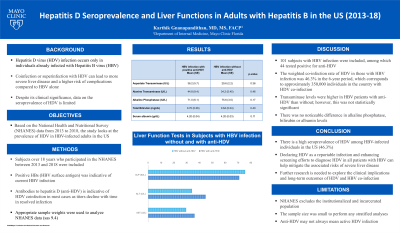Sunday Poster Session
Category: Liver
P1152 - Hepatitis D Seroprevalence and Liver Functions in Adults With Hepatitis B Infection in the US, 2013-2018
Sunday, October 27, 2024
3:30 PM - 7:00 PM ET
Location: Exhibit Hall E

Has Audio

Karthik Gnanapandithan, MD, MS
Mayo Clinic
Jacksonville, FL
Presenting Author(s)
Karthik Gnanapandithan, MD, MS
Mayo Clinic, Jacksonville, FL
Introduction: Hepatitis D virus (HDV) infection occurs only in individuals already infected with Hepatitis B virus (HBV). Coinfection or superinfection of HDV can lead to more severe liver disease and a higher risk of complications compared to HBV alone. Despite its clinical significance, data on the seroprevalence of HDV remains limited. Based on the National Health and Nutritional Survey (NHANES) data from 2013 to 2018, this study aims to determine the prevalence of HDV in HBV-infected individuals, providing insight into the epidemiology and potential public health implications of HDV in the US.
Methods: The study included subjects over 18 years who participated in the NHANES between 2013 and 2018. Those with positive HBs antigen were considered to have current HBV infection. The presence of antibodies to hepatitis D (anti-HDV) indicated past or present infection. Since most patients with HDV progress to chronic infection and titers decline with time in resolved cases, the majority of these represent ongoing HDV coinfection. Data from interviews and serology were used in the study. Sas 9.4 survey package was used to calculate the weighted percentage in the national population using appropriate sample weights.
Results: 101 subjects with HBV infection were included, among which 44 tested positive for anti-HDV. The weighted co-infection rate of HDV in those with HBV infection was 46.3% in the 6-year period. This corresponds to approximately 350,000 individuals in the country with HDV co-infection. The co-infection rate was 52.7% in 2013-14, 61.6% in 2015-16, and 20% in 2017-18. Transaminase levels were higher in HBV patients with anti-HDV than without; however, this was not statistically significant (Table 1).
Discussion: Our study reveals a high seroprevalence of HDV among HBV-infected individuals in the US population, with an overall co-infection rate of 46.3% over the six-year period. The reduction in coinfection rate in 2017-18 may highlight changes in epidemiological trends, but this needs to be confirmed with larger longitudinal studies. Declaring HDV as a reportable infection and enhancing screening efforts to diagnose HDV in all patients with HBV can help mitigate the associated risks of severe liver disease. The results can inform public health strategies and clinical practices to improve patient outcomes. Further research is needed to explore the clinical implications and long-term outcomes of HDV and HBV co-infection in the US.
Note: The table for this abstract can be viewed in the ePoster Gallery section of the ACG 2024 ePoster Site or in The American Journal of Gastroenterology's abstract supplement issue, both of which will be available starting October 27, 2024.
Disclosures:
Karthik Gnanapandithan, MD, MS. P1152 - Hepatitis D Seroprevalence and Liver Functions in Adults With Hepatitis B Infection in the US, 2013-2018, ACG 2024 Annual Scientific Meeting Abstracts. Philadelphia, PA: American College of Gastroenterology.
Mayo Clinic, Jacksonville, FL
Introduction: Hepatitis D virus (HDV) infection occurs only in individuals already infected with Hepatitis B virus (HBV). Coinfection or superinfection of HDV can lead to more severe liver disease and a higher risk of complications compared to HBV alone. Despite its clinical significance, data on the seroprevalence of HDV remains limited. Based on the National Health and Nutritional Survey (NHANES) data from 2013 to 2018, this study aims to determine the prevalence of HDV in HBV-infected individuals, providing insight into the epidemiology and potential public health implications of HDV in the US.
Methods: The study included subjects over 18 years who participated in the NHANES between 2013 and 2018. Those with positive HBs antigen were considered to have current HBV infection. The presence of antibodies to hepatitis D (anti-HDV) indicated past or present infection. Since most patients with HDV progress to chronic infection and titers decline with time in resolved cases, the majority of these represent ongoing HDV coinfection. Data from interviews and serology were used in the study. Sas 9.4 survey package was used to calculate the weighted percentage in the national population using appropriate sample weights.
Results: 101 subjects with HBV infection were included, among which 44 tested positive for anti-HDV. The weighted co-infection rate of HDV in those with HBV infection was 46.3% in the 6-year period. This corresponds to approximately 350,000 individuals in the country with HDV co-infection. The co-infection rate was 52.7% in 2013-14, 61.6% in 2015-16, and 20% in 2017-18. Transaminase levels were higher in HBV patients with anti-HDV than without; however, this was not statistically significant (Table 1).
Discussion: Our study reveals a high seroprevalence of HDV among HBV-infected individuals in the US population, with an overall co-infection rate of 46.3% over the six-year period. The reduction in coinfection rate in 2017-18 may highlight changes in epidemiological trends, but this needs to be confirmed with larger longitudinal studies. Declaring HDV as a reportable infection and enhancing screening efforts to diagnose HDV in all patients with HBV can help mitigate the associated risks of severe liver disease. The results can inform public health strategies and clinical practices to improve patient outcomes. Further research is needed to explore the clinical implications and long-term outcomes of HDV and HBV co-infection in the US.
Note: The table for this abstract can be viewed in the ePoster Gallery section of the ACG 2024 ePoster Site or in The American Journal of Gastroenterology's abstract supplement issue, both of which will be available starting October 27, 2024.
Disclosures:
Karthik Gnanapandithan indicated no relevant financial relationships.
Karthik Gnanapandithan, MD, MS. P1152 - Hepatitis D Seroprevalence and Liver Functions in Adults With Hepatitis B Infection in the US, 2013-2018, ACG 2024 Annual Scientific Meeting Abstracts. Philadelphia, PA: American College of Gastroenterology.
